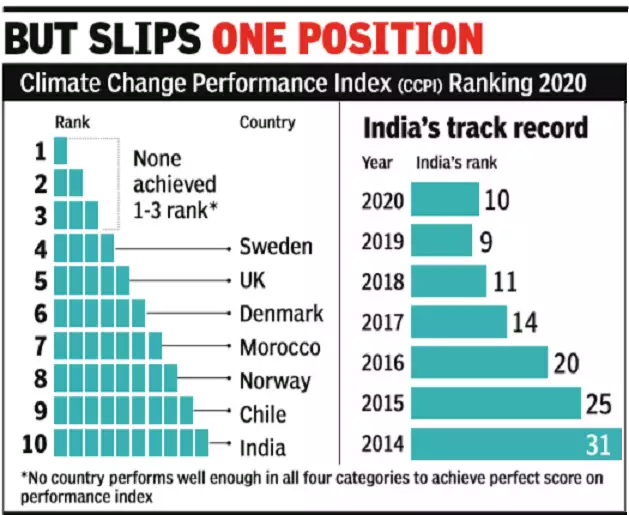Climate Change Performance Index | 10 Dec 2020
Why in News
India ranked 10th in Climate Change Performance Index (CCPI) 2021.
- India, for the second time in a row, continued to remain in the top 10.
- Last year, India had been ranked at the ninth position.
Key Points
- About Climate Change Performance Index (CCPI):
- Published by: Germanwatch, the New Climate Institute and the Climate Action Network annually since 2005.
- Scope: It is an independent monitoring tool for tracking the climate protection performance of 57 countries and the European Union.
- These countries together generate 90%+ of global greenhouse gas emissions.
- Aim: It aims to enhance transparency in international climate politics and enables comparison of climate protection efforts and progress made by individual countries.
- Criteria: The CCPI looks at four categories, with 14 indicators: Greenhouse Gas Emissions (40% of the overall score), Renewable Energy (20%), Energy Use (20%), and Climate Policy (20%).
- CCPI 2021:
- Top three ranks were empty as no country had met the criteria to get placed high enough on the index.
- Only two G20 nations, the United Kingdom and India are among the high rankers in CCPI 2021, which covers the year 2020.
- Six other G20 nations including the USA, Canada, South Korea, Russia, Australia and Saudi Arabia are ranked at the bottom of the index.
- This is the second time in a row that the USA (ranked last), which is the largest historical polluter, is ranked at the bottom.
- China, which is the biggest current emitter of greenhouse gases, is ranked at the 33rd position on the CCPI 2021 report.
- India’s Performance:
- Overall Performance: India ranked 10th and scored 63.98 points out of 100.
- Renewable Energy: India has been ranked at 27th out of 57 countries under the category this time. Last year, the country was ranked at 26th.
- In September 2019, at the United Nations Climate Action Summit, India announced increasing the renewable energy target to 450 GW by 2030 from 175 GW by 2022.
- In its Intended Nationally Determined Contribution (INDC), India has pledged to increase the share of non-fossil fuels-based electricity to 40% by 2030.
- Emissions: Per capita emissions stayed at a comparatively low level. India was ranked 12th.
- BS-VI Emission Norms: India moved to BS-VI Emission Norms to control the emissions from the automobiles.
- Climate Policy: India’s performance was rated as medium (13th).
- The National Action Plan on Climate Change (NAPCC) was launched in 2008 which aims at creating awareness among the representatives of the public, different agencies of the government, scientists, and the industry on the threat posed by climate change and the steps to counter it.
- Energy Use: India was ranked High (10th) under this category.
- The country has not only established a comprehensive policy for energy efficiency – National Mission for Enhanced Energy Efficiency (NMEEE), but has also executed successful demand side management programmes for consumers and municipal corporations to achieve overall energy savings while gradually mitigating the impact of climate change.
- NMEEE is a part of NAPCC.
- The country has not only established a comprehensive policy for energy efficiency – National Mission for Enhanced Energy Efficiency (NMEEE), but has also executed successful demand side management programmes for consumers and municipal corporations to achieve overall energy savings while gradually mitigating the impact of climate change.
- Suggestion for India:
- India's climate change mitigation strategy should include post-Covid-19 recovery plans, according to the report. These include reducing fossil fuel subsidies, phasing out coal, better coordination between the central and state governments and raising self-sufficiency by domestic manufacturing in the renewable sector.

